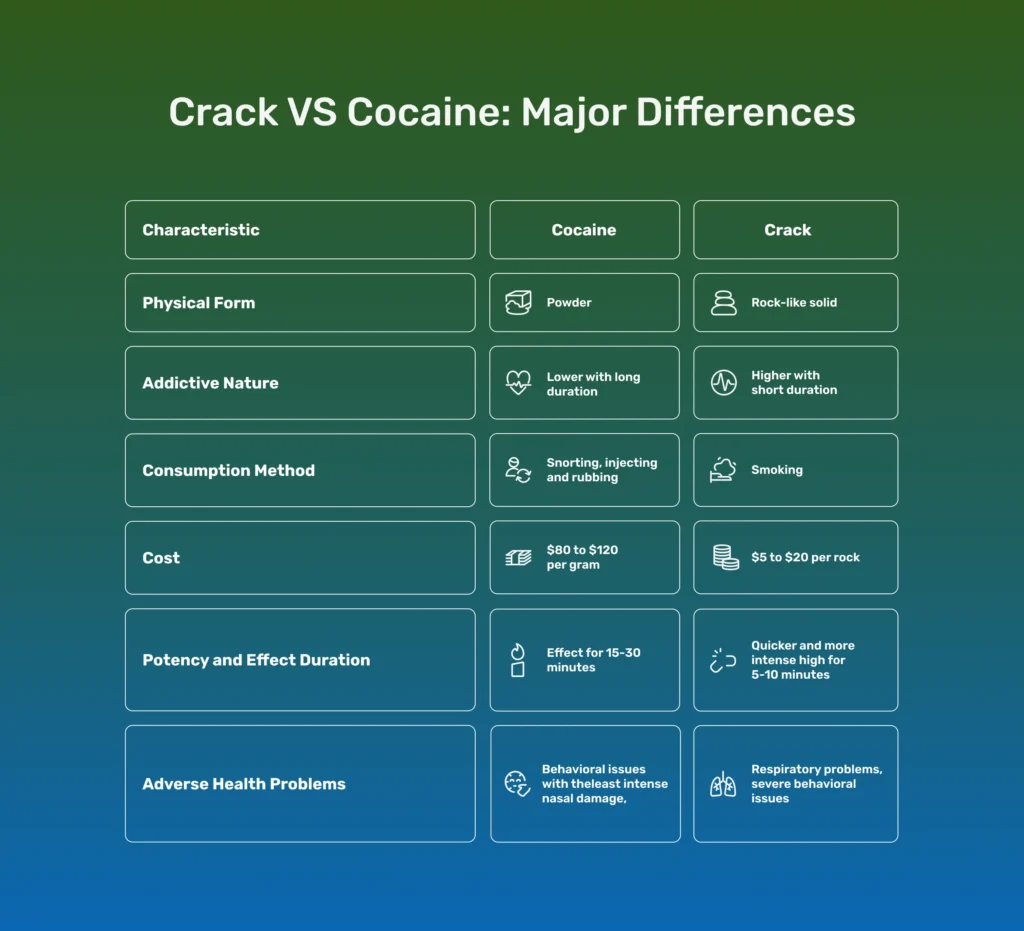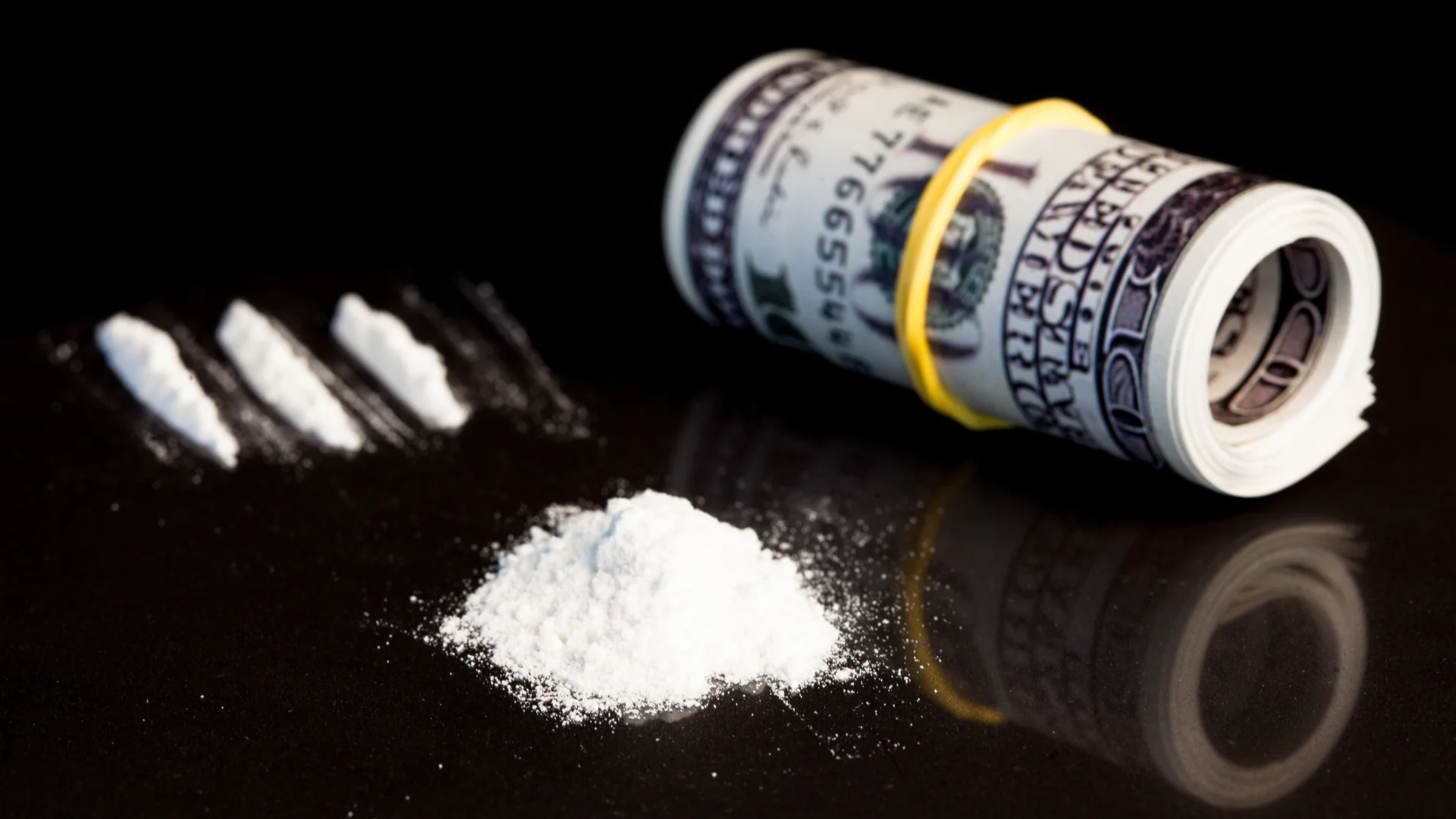Drug addiction has been a serious problem for humanity for centuries. Crack and cocaine are two of the most popular substances that are still being used by a wide range of people. Both cocaine and crack are unique forms of the same drug.
But what is the difference between cocaine and crack? There are different factors, such as legal status, chemical composition, consumption method, accessibility, cost, intensity, and health effects, to differentiate cocaine from crack.
What is Cocaine?
Cocaine vs crack cocaine is one of the most powerful drugs extracted from the leaves of the coca plant. It is popular for its different intense effects on the addict’s nervous system, resulting in higher intensity for a short period.
The most popular form of cocaine is the whit powder, which is known as snow, blow, or coke. Addicts consider snorting or injection methods for addiction purposes. Injecting or snorting cocaine offers a boost in energy, confidence, and euphoria.
What is Crack?
Crack is a highly addictive and powerful form of cocaine. It becomes off-white and a small yellowish crystal. The addicts use a pipe to smoke the crack. This rock-like crystal is named after its cracking sound after going through the heating process.
The smoking ensures that the drug reaches the lungs fast and is absorbed into the bloodstream before reaching the addict’s brain. Smoking crack provides a boost in confidence, alertness, and energy.
What is Crack Cocaine?
Crack cocaine is processed into powdered cocaine and is available in different forms. The process of making crack cocaine includes mixing powder cocaine with water and baking soda before heating the mixture to form the solid crystals or rocks.
This process makes it a smokable substance by separating the cocaine from the hydrochloride. Crack cocaine vs cocaine is usually smoked, ensuring quick accessibility of the drug to the mind.
What is Cocaine Addiction?
Cocaine addiction is a stimulant use disorder that is caused due to frequent and excessive intake of cocaine for a long time through different consumption options such as injection and smoking. When you become addicted to cocaine, it becomes impossible to stop consuming it. Cocaine addiction can result in different serious physical and mental health problems due to its chemical composition.
Crack VS Cocaine Major Differences
What’s the difference between crack and cocaine? There are some fundamental differences between cocaine and crack in terms of accessibility, chemical composition, intensity, duration, and different adverse health effects. Let’s explore the differences between cocaine and crack:
| Difference | Cocaine | Crack |
| Physical Form | Powder | Rock-like solid |
| Addictive | Lower with long-duration | Higher with short-duration |
| Consumption Method | Snorting, injecting, and rubbing | Smoking |
| Cost | $80 to $120 per gram | $5 to $20 per rock |
| Potency and Effect Duration | Effect for 15-30 minutes | Quicker and more intense high for 5-10 minutes |
| Adverse Health Problems | Behavioral issues with the least intense, nasal damage, | Respiratory problems, severe behavioural issues |

Legal Status
The use of cocaine for medical purposes is legal. However, individuals are using this substance illegally. The Controlled Substances Act (CSA) imposed strict laws on the manufacturing, distribution, and use of cocaine, which is a Schedule II substance. There are also mandatory sentences for crack responding to the “crack epidemic.”
The penalty of criminal law allows triggering of the quantity of crack cocaine and powder cocaine in a 100-to-1 ratio. The Fair Sentence Act 2010 reduced the penalty ratio to 10-to-1 for crack cocaine. Moreover, the First Step Act of 2018 eliminated the mandatory minimum sentence for possessing crack cocaine.
Accessibility and Cost
Powder cocaine vs crack has been more expensive. The powder cocaine is available in most markets at a rate of around $80 to $120 per gram. On the other hand, crack is also accessible at a rate of $5 to $20 per individual rock. The affordability of crack makes it the ideal drug option for lower-income communities.
Preparation and Physical Look
Powder cocaine has an appearance like flour or talcum powder. Street cocaine is prepared by mixing it with different substances such as talc, baking soda, or cornstarch. Crack is a smaller crystal or rock with a yellowish or off-white color. The appearance of the crack can vary due to processing and is available in different sizes, from large chunks to tiny pebbles.
Chemical Makeup
Is cocaine the same as crack? Yes, both crack and cocaine are the same substance. Cocaine is available in two forms such as crack and white powder (cocaine hydrochloride). The chemical reaction takes place between the mixture of ammonia and hydrochloride or water with the baking soda, which undergoes the heating process to eliminate hydrochloride and result in a solid substance.
Consumption Method
Cocaine is usually snorted, and it can also be mixed with water for injecting purposes. Injecting offers a higher effect with high intensity for a short time as compared to snorting. Moreover, powder cocaine can also be ingested by rubbing it on the gums.
Crack is usually smoked after being dissolved in water. It offers quicker and more potent effects for a longer time than the snorting or injecting of powder cocaine. Injecting powder cocaine or smoking crack after dissolving it in water offers similar effects.
Duration and Intensity
There are similar effects of crack and cocaine, with a different timeline. Powder coke vs crack offers a high for 15 minutes to 30 minutes in the case of snorting. There are gradual effects with the slower decline.
Crack provides a higher effect, but only for 5 to 10 minutes. The quick effect and faster decline encourage users to use intaking crack to maintain the first euphoria. Therefore, individuals become easily addicted to crack.
Adverse Health Effects
Small cocaine doses offer alertness, euphoria, and happiness. However, frequent and larger doses lead to adverse health issues such as violent or erratic behavior. Short-term and immediate health problems include:
- Dilated pupils
- Increased body temperature
- Higher blood pressure
- Nausea
- Restlessness
Long-term use of cocaine in different forms can result in long-term health effects, such as different diseases of the cardiovascular and neurological systems. It also damages different body organs, including the kidneys and liver, depending on the individual and their consumption methods.
Smoking crack cocaine can affect asthma and the lungs. Snorting cocaine can badly affect the nasal cavity, resulting in the loss of sense of smell, a chronic runny nose, and nosebleeds. Injecting cocaine brings health problems such as hepatitis and HIV.
Pharmacological and Chemical Reality of Cocaine and Crack
Both crack and powder cocaine are pharmacologically identical and contain the same cocaine. The major difference between the powder and crack cocaine is the absence of the hydrochloride salt in the crack, making it a smokable substance.
Addiction Potential
Crack is considered more addictive than powder cocaine in terms of its largely consumption rather than the chemical differentiation. Smoking crack makes it a highly potent drug, offering a fast and intense high. There are several risks of both drugs, and continuous use can result in cocaine dependence.
Brain Effects
Both substances block dopamine in your brain’s reward system. This blockage forces dopamine to stay in the synapses, ensuring euphoric effects. The timeline and intensity of these drugs depend on how much time a substance takes to reach the brain, not chemical and pharmacological differences in substances.
Need Help with Treatment of Cocaine Addiction? Contact Us Now
Chemical Composition
Crack and cocaine differ in the preparation phase and chemical composition, although they are extracted from the same coca plant with similar effects. Cocaine is a powerful drug that can easily affect the nervous system, which has been used in religious ceremonies and medication in South America.
Crack is an addictive and potent drug due to its processing. Mixing with an alkaline substance and heating forms a crystal drug. It is the most concentrated form of cocaine without the impurities.
Base and Salt Form
Cocaine is a salt that ensures easy dissolution in water and absorption by the body. Injecting, snorting, and rubbing the gums are different methods of ingesting cocaine. The digestion of cocaine takes a longer time to provide a higher intensity for a short time interval. Cocaine is an ideal source of increasing alertness, energy, and euphoria.
Crack is a base without dissolution in water, and smoking is essential for absorption. Smoking crack ensures a high intensity within a few seconds for a long time, as compared to different forms of cocaine. It increases body temperature, blood pressure, and heart rate alongside invincibility, confidence, and euphoria.
Purity Level
Cocaine is usually mixed with different substances, including baking soda and talcum powder, ensuring more profits for the dealers. It means the purity of street cocaine varies, and the user has no idea about the exact quantity of cocaine. The mixing of cocaine with other drugs makes the users addicted to different drugs.
Crack is the most concentrated form of cocaine, which makes it the most potent drug for users. It is usually available in small batches with the least chance of being mixed with other substances. This higher purity of crack vs coke (cocaine) also ensures that a user may become more addicted to crack as compared to different types of cocaine.
Myths and Facts About Crack Cocaine
Myth 1: Crack cocaine is more addictive and harmful than powder cocaine.
Fact
Both forms of cocaine are chemically processed. There are minor differences between powder cocaine and crack cocaine, which are only in in taking form. Dissolving powder cocaine in water and injecting offers the highly intense and psychoactive effects for a short time. There are the same psychoactive effects for snorting powder cocaine and smoking crack.
It is important to note that smoking any drug offers quicker and high intense psychoactive effects. Therefore, higher or lower effects are only because of the drug intake method, not the chemical form.
Myth 2: African Americans are more addicted to crack.
Fact
This myth is based on the societal point of view that people from the lower economic classes are more likely to use crack. The reason behind this myth is that crack is more affordable than powder cocaine. However, a lot of Americans who have no African ethnic background smoke crack.
Myth 3: Crack is worse than other drugs.
Fact
This social myth was started in the 1980s to convey that crack babies are worse off than babies of mothers who are addicted to other drugs. Pregnant women who smoked crack give birth to kids who are addicted to cocaine and face different cognitive and social problems.
There is no validation that “crack babies” are different from children whose mothers have abused alcohol, powder cocaine, or heroin. Crack babies are affected by poverty and neglect, not the mothers addicted to crack.
Myth 4: Crack cocaine results in more violence and aggression as compared to powder cocaine.
Fact
There is no valid evidence to support this myth. Aggression and violence are a result of different variables, not the use of crack cocaine vs powder cocaine.
Myth 5: Stringent penalties for possession and use of crack cocaine than powder cocaine.
Fact
There are stringent penalties for using or possessing crack cocaine as compared to possessing or using powder cocaine. However, there is no evidence to support this myth of comparing the penalties. Both crack cocaine and powder cocaine are different forms of cocaine, and there is no reason to impose a harsher sentence on individuals using crack cocaine.
Symptoms of Cocaine and Crack Addiction
The American Psychiatric Association (APA) uses the term stimulant use disorder for those people who are using and suffering from cocaine. An individual can experience a substance use disorder when they face the negative effects of using powder cocaine or crack cocaine.
There are no formal diagnostic tests for detecting the use of cocaine. A licensed mental health clinic can conduct diagnostic tests for both the use of crack and powder cocaine. The following symptoms indicate that individuals are suffering from stimulant use disorder.
- Excessive and Frequent Use: Using the crack cocaine in larger quantities and for a longer time than the intended use.
- Cocaine Craving: A person continues to use cocaine even if they intend to cut down or stop the use.
- Negative Effects: Abusing cocaine can result in different negative effects, such as social problems and challenges in relationships.
- Loss of Control: An individual spends time possessing and using the cocaine.
- Emotional and Physical Effects: The continuous use of cocaine leads to physical and psychological effects.
- Violence: Using cocaine excessively can result in violent behaviors such as aggression.
- Unability to Fulfill Obligations: People addicted to cocaine are unable to fulfill different obligations at home as well as workplace.
What are the Effects of Withdrawing from Cocaine Dependence?
When an individual becomes excessively dependent on cocaine, their brain and body want to always contain this substance. It becomes difficult for addicts to stop or withdraw from the use of cocaine. There are different cognitive and psychological effects of withdrawing from cocaine. The following symptoms appear within a few hours to days after the cocaine withdrawal:
- Craving
- Depression
- Fatigue
- Hypersomnia or insomnia
- Increased appetite
- Paranoia
- Vivid dreams
Get Rehabilitation Help to Withdraw from Cocaine Safely
Are you addicted to cocaine and want to get rid of it to live a healthy life? You are not alone because several people are looking for help to deal with addiction through the best medical support. The medical professionals at MD Rehab Center, with years of experience in rehabilitation, ensure a smooth withdrawal process.
Call Us Today for a safe and speedy recovery from the use of Cocaine
Cocaine use disorder has become a public health problem affecting several families. Get in touch with MD Rehab Center for cocaine addiction treatment.
What’s the chemical difference between crack and cocaine?
The hydrochloride salt of cocaine is processed to form a white powder, and crack is made by mixing the cocaine with baking soda or ammonia.
What is a street name for crack?
The street name for crack is sleet, base, or rock.
Do you get more time for crack or coke?
You get more time for crack on average 1.6 to 1.3 longer as compared to the coke.
What is the chemical name for cocaine?
The chemical name for cocaine is methyl ester of benzoylecgonine.
What’s the difference between snow and crack?
Snow is a white crystalline powder, whereas crack is the rock form of cocaine.
Is crack the same as cocaine?
Yes, crack is the same as cocaine because crack is a solid form of cocaine.


